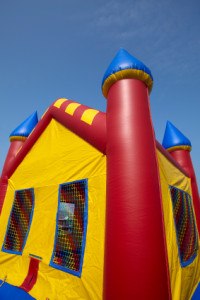

 In the last two months alone the media has reported at least 10 bounce house or inflatable amusement rides nationwide that were toppled by wind or collapsed under weight of too many kids. The U.S. Consumer Products Safety Commission continues to estimate the number of injuries annually at over 6,000.
In the last two months alone the media has reported at least 10 bounce house or inflatable amusement rides nationwide that were toppled by wind or collapsed under weight of too many kids. The U.S. Consumer Products Safety Commission continues to estimate the number of injuries annually at over 6,000.
As insurance professionals, we’ve become accustomed to viewing so-called “difficult risks,” those that some carriers shy away from. In some cases, agents and brokers may choose not get involved with these risks because they believe a market is too difficult to find or because they do not understand the risks. But I see this as a growing industry that can offer a good income for responsible operators and new business opportunities for agents and brokers.
While recent media reports may lead some to believe that “inflatables” are inherently dangerous by design and should be outlawed, I do not agree. However, I do wonder if we can reduce the number of accidents involving inflatables and what the responsible parties can do to provide a safer play environment for children.
The process begins with the manufacturers. As an amusement industry insider and voracious advocate for ride safety, I applaud the steps the major manufacturers have taken to build and design Inflatables today. They don’t design these units to hurt kids. They design them to provide safe and affordable fun. By and large, they accomplish that goal. The designs of today are significantly safer than those of 10 and 20 years ago. However, the manufacturers must maintain their diligence for continuous design improvement and in communicating safe operating information.
Operators bear the brunt of the challenge and responsibility for a change towards safety. They must adopt a “zero tolerance” policy for unsafe operations. Safety and maintenance cannot take a back seat to revenue and profit. I recently received an email from one operator who, when asked about the mandating of supervision, stated, “Quite frankly, if we get mandated to supply supervision, it will kill the industry. The kids don’t listen to their own parents, let alone our help.”
What he fails to understand is that accidents and the media coverage that follow will kill the industry more quickly than anything else. Operators are on the front line, the purveyors of fun and the individuals ultimately responsible for safe operation. They have to recognize that in order to perpetuate this industry safety must be a part of their DNA and must not be sacrificed for any reason.
Parents also have significant responsibility. The devices are not 600-pound blow-up baby sitters. If parents take their children to an amusement park, don’t they sit there and WATCH their child go on the ride? Why would they just let their children run wild and free when it is a bounce house or inflatable slide? Far too often, parents cede their parental responsibility to operators or event staff, assuming that all is safe. Parents must work with ride operators to make sure a child is observing all rules and playing appropriately. This also holds true for the instances where these devices are “dropped” off for a backyard birthday party. If the rental company charges extra for a trained operator, parents should pay it.
Lastly there is the responsibility of industry and the government. Currently 19 states have some form of regulation involving inflatable amusement devices; however, most pin their hopes of safety on simple inspections and annual fees. They miss the true opportunity to promote safety through education by making sure the operators know how to properly set up and operate the device. The most proactive state for Inflatable safety is Pennsylvania. They require Inflatables to be inspected by a certified inspector prior to each use. They host annual training for operators and equipment owners on ride safety and operation and empower them with the responsibility for the inspections and safe operation.
Both the industry as a whole and the states have the ability to improve safety now. Children can be safe playing in a bounce house as long as everyone accepts the responsibilities that come with enjoying these devices.
Agents and brokers can also play a role in their local community. If they are connected with the right insurance partners, they can provide valuable risk management and safety information to their clients, the amusement operators. In the process, they will have – besides a good source of business — a feeling they are helping to provide a safer play environment for children.
Tewksbury is program manager for Amusement Insurance Resources at Allegiant Programs Group (www.insureair.com). He is certified as an Amusement Ride Inspector through the National Association of Amusement Ride Safety Officers and holds inspection licenses in numerous states.